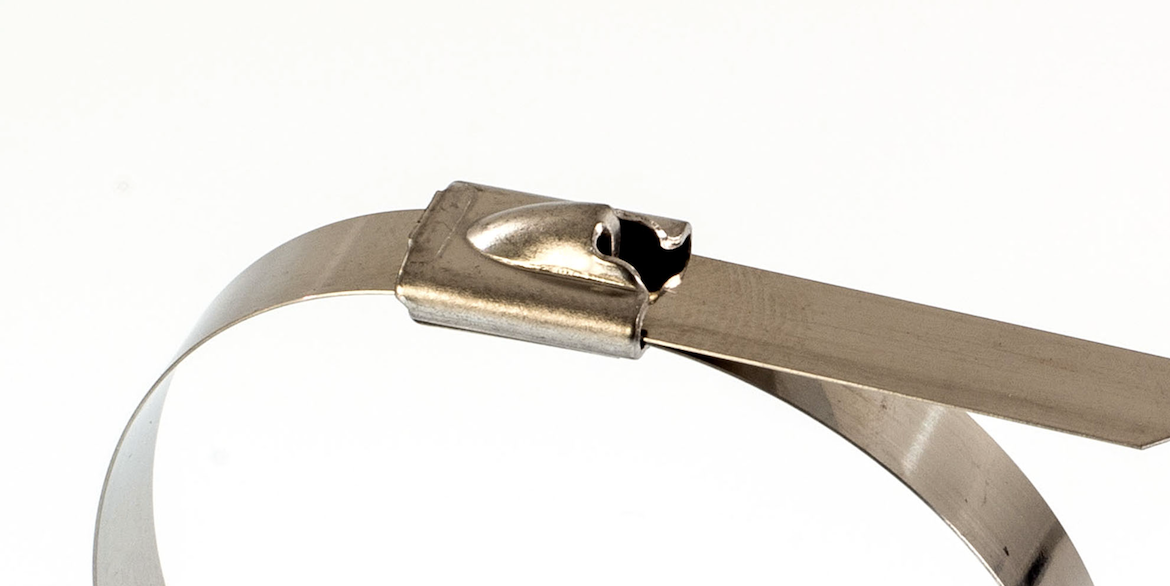How you apply a zip tie depends on the type you are using.
We’ll take a look at the main types of lock and release mechanisms used to secure zip ties to differentiate the different options, and outline which is best for which situation.
Zip ties usually come in either single-use or reusable, with the majority of zip ties having a single use locking mechanism.
However, there is a range of standard nylon zip ties with a releasable locking mechanism, that allows you to reuse the zip ties multiple times.
Standard Nylon Zip Ties Single-Use Locking Mechanism
Standard nylon zip ties have a single use self-locking mechanism for easy application.
You simply insert the tail of the zip tie through the square locking piece, and then pull the tie through the main head to set the length of excess material.
When adjusting the length of the tie, the tail can only be pulled through forwards, and not backwards. If inserted correctly, you will hear the teeth clicking over the ridges as the tie is tightened.
Once the cable is secured, you can choose to cut off the excess material if you wish to keep the tie neat and tidy.
If you are applying a large number of zip ties you could consider using a zip tie gun / fastening and tensioning tool, which will make the process of applying multiple ties quicker, easier and more efficient.
Zip tie installation tools are ideal for fastening and automatic cutting, reducing the need to conduct the task by hand.
Reusable Zip Ties
Standard releasable nylon zip ties provide the option to secure the tie, and then intentionally releasable the tie through a releasable locking mechanism.
These ties are ideal for situations where cables or wires might be needed to be added or removed, allowing greater versatility.
Make sure not to cut the end of the tie once it’s been applied if you wish to expand the bundle diameter needed to add more ties to a bundle.
You may need the additional length in the future, so you may wish to not cut the excess material from your releasable ties when applying.
There are two types of releasable locking mechanisms, the trigger release and extended tooth mechanism.
Let’s take a look at both.
Trigger Resealable Zip Ties
The trigger release mechanisms can be secured, then intentionally released by hand, making it ideal for temporary fastening solutions.
The release clip allows for new bundles to be added, or removed, multiple times. They are designed to be quickly and easily released by hand.
These ties are just as durable and resistant to external agents as their standard single-use counterparts.
Extended Tooth Resealable Zip Ties
The extended tooth mechanism tie, on the other hand, has a smaller release mechanism that requires a screw driver or the end of a nail to apply pressure for the tie to be released.
The extended tooth are larger in size, providing a stronger solution with a higher minimum tensile strength due to their additional width.
Stainless Steel Zip Ties
Stainless steel zip ties can also be applied by either hand or through the use of a specialized tool.

These ties have a roller ball locking mechanism that is equally easy to install, with a locking ball bearing that secures the tie as the tensions increases.
Which Locking Mechanism is Best?
If you’re looking to use a zip tie multiple times, the releasable nylon zip tie is an ideal solution. But be careful not to cut the excess tail of the zip tie if you plan to re-use the tie for a number of purposes, as the extra length may come in handy.
If it’s a permanent solution you’re looking for, either the single use nylon zip tie or the stainless steel zip tie would be the right solution. With the added strength and resistance to harsh environments favouring the added protection provided with the stainless steel tie.
*Please note that we don't sell all these zip ties mentioned here currently on our website but we are working on getting them live as soon as possible. Thanks for your patience.


